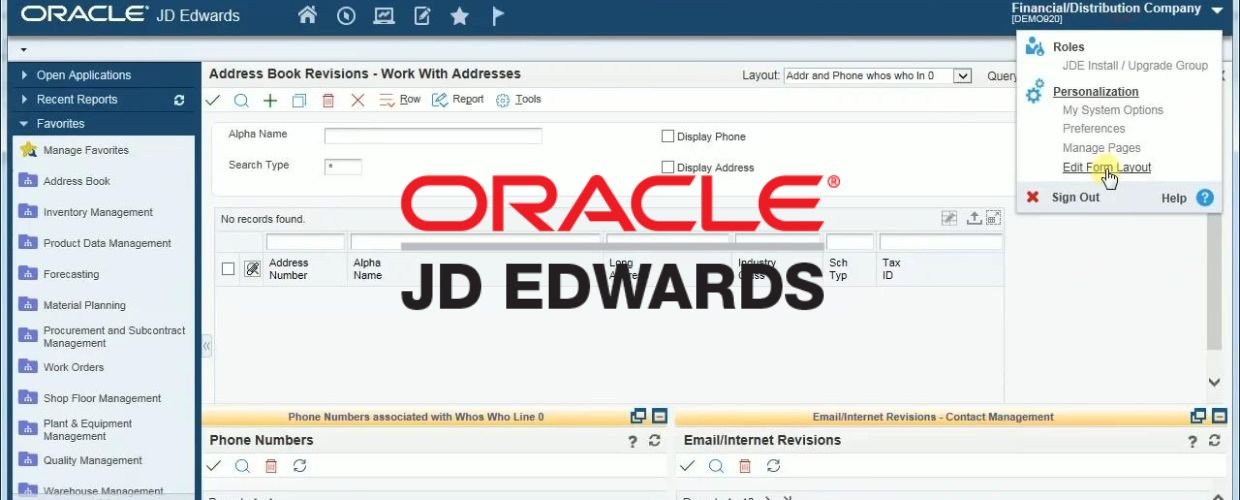JD Edwards EnterpriseOne can adapt to the evolving needs of businesses, supporting growth and expansion. The software offers industry-specific functionality, allowing organizations to leverage pre-built best practices and workflows tailored to their respective sectors. This article discusses JD Edwards EnterpriseOne user reviews, features, benefits, limitations, and alternatives.
What is JD Edwards EnterpriseOne?
JD Edwards EnterpriseOne is an integrated enterprise resource planning (ERP) software suite developed by Oracle Corporation. It provides a comprehensive set of applications for managing various aspects of business operations, including finance, manufacturing, distribution, human resources, supply chain management, and customer relationship management.
EnterpriseOne is designed to support large and medium-sized businesses across different industries, offering various modules and functionality to meet their needs. It enables organizations to streamline processes, automate tasks, improve efficiency, and make informed decisions based on real-time data.
User review of JD Edwards EnterpriseOne
JD Edwards EnterpriseOne receives mostly positive reviews from several user review sites. Users at Trustradius rate JD Edwards EnterpriseOne at 8.2 out of 10, users at Software Advice rate them at 4.1 out of 5.0, and users at Getapp them at 4.2 out of 5.0
Features of JD Edwards EnterpriseOne
JD Edwards EnterpriseOne offers comprehensive features that enable organizations to manage their business processes and drive operational efficiency effectively. Some of the features are given below:
Scalability and Flexibility
It is highly scalable, creating it suitable for small and large enterprises. It can handle the complex requirements of global organizations with multiple subsidiaries and business units. The software allows businesses to adapt and customize the system to align with their unique processes, industry-specific needs, and evolving business strategies. This flexibility ensures that It can grow and evolve with the organization.
Integrated Suite of Applications
JD Edwards EnterpriseOne provides a fully integrated suite of applications that cover various functional areas of business operations. This integrated approach eliminates the need for multiple standalone systems and promotes seamless data flow across departments. Users can access real-time information and insights from different modules, facilitating better decision-making and enabling end-to-end visibility of business processes.
Industry-Specific Functionality
The software offers industry-specific functionality to cater to the unique requirements of different sectors. Whether manufacturing, distribution, construction, healthcare, or retail, It provides specialized modules and capabilities tailored to specific industries. This industry focus allows businesses to leverage pre-built best practices, workflows, and configurations, saving time and effort in system setup and customization.
Advanced Reporting and Analytics
It provides powerful reporting and analytics capabilities, helping users to achieve valuable insights into their business performance. The software offers various reporting tools and dashboards that enable users to generate customized reports, perform ad-hoc queries, and visualize data meaningfully. With real-time analytics, organizations can monitor key metrics, track trends, identify opportunities, and address potential issues promptly.
Benefits of JD Edwards EnterpriseOne
JD Edwards EnterpriseOne offers numerous benefits organizations can leverage to optimize their business processes, increase efficiency, and drive growth. Some of the benefits are given below:
Comprehensive Functionality
It provides various modules and features that cover various aspects of business operations. The software offers comprehensive functionality to support end-to-end business processes, whether financial management, supply chain management, manufacturing, human resources, or customer relationship management.
Enhanced Visibility and Decision-Making
With real-time data access and advanced reporting and analytics capabilities, organizations can gain comprehensive visibility into their business operations. Users can monitor key performance indicators, track trends, and generate customized reports and dashboards to make informed decisions.
Streamlined and Automated Processes
It helps streamline and automate business processes, reducing manual effort and increasing operational efficiency. The software provides workflow automation, allowing organizations to define and enforce standardized processes across departments. This automation eliminates redundant tasks, reduces errors, and accelerates process execution, improving productivity and cost savings.
Mobile and Cloud Capabilities
JD Edwards EnterpriseOne supports mobility and cloud deployment, providing users access to critical business information anytime. The software offers mobile applications that enable employees to perform tasks on the go, improving productivity and responsiveness. Moreover, with cloud deployment options, organizations can leverage the benefits of scalability, cost-effectiveness, and ease of maintenance associated with cloud computing.
Limitations of JD Edwards EnterpriseOne
While JD Edwards EnterpriseOne is a powerful and versatile ERP solution, it also has certain limitations that organizations should consider. Some of the limitations are given below:
Complexity and Learning Curve
It is a robust and feature-rich software suite, which can lead to a steep understanding curve for new users. The software’s complexity and extensive functionality may require significant training and expertise to utilize its capabilities fully. It can result in a longer implementation period and potential challenges during the initial stages of adoption.
Customization Challenges
While It allows customization and configuration to align with specific business needs, extensive customization can introduce complexity and maintenance challenges. Organizations must carefully balance customization requirements with the need for future system updates and upgrades. Overly customized instances can hinder the ability to implement new features or apply system patches, potentially leading to compatibility issues and increased maintenance efforts.
Limited Support for Emerging Technologies
JD Edwards EnterpriseOne may have limited support for emerging technologies and trends, for example, artificial intelligence (AI), machine learning (ML), and advanced analytics. While the software provides robust reporting and analytics capabilities, organizations seeking cutting-edge AI or ML capabilities may need to explore additional solutions or integrations outside the JD Edwards ecosystem.
User Interface
The user interface (UI) of JD Edwards EnterpriseOne has been criticized for its outdated design and lack of modern aesthetics. The UI may not provide the intuitive and user-friendly experience some users expect from contemporary software solutions. While Oracle has made efforts to improve the UI in recent updates, organizations may find it necessary to invest in additional UI enhancements or customization to enhance user adoption and satisfaction.
Alternatives of JD Edwards EnterpriseOne
Several alternatives to JD Edwards EnterpriseOne offer similar services and features. Evaluating each alternative based on your needs and requirements is important to determine the best solution for you.
Some popular alternative solutions to JD Edwards EnterpriseOne include Odoo, Quickbooks Online, TallyPrime, Wave Accounting, Zoho Books, Hal Business Success, and Holded.
Conclusion
JD Edwards EnterpriseOne is a comprehensive and feature-rich ERP software suite developed by Oracle Corporation. It offers various functions to support various aspects of business operations, including finance, manufacturing, supply chain management, human resources, and customer relationship management.
Organizations should carefully evaluate their needs, industry requirements, and IT landscape to determine if it fits their business. By leveraging its strengths and considering its limitations, organizations can make informed decisions and effectively utilize It to optimize operations, drive growth, and stay competitive in the dynamic business environment.



